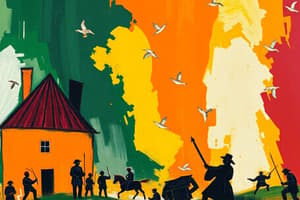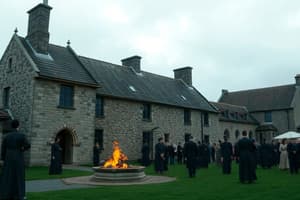Podcast
Questions and Answers
Which of the following is an example of a primary source?
Which of the following is an example of a primary source?
- A biography of a historical figure
- A photograph from the event (correct)
- A history textbook
- A documentary film
Bias refers to an impartial view influenced by facts and an objective perspective.
Bias refers to an impartial view influenced by facts and an objective perspective.
False (B)
What was the outcome of the 1918 Irish Election?
What was the outcome of the 1918 Irish Election?
Sinn Féin won most of the Irish seats in the UK Parliament, promoting Irish independence.
The _____ describes the planned extermination of a particular ethnic group.
The _____ describes the planned extermination of a particular ethnic group.
Match the following events with their corresponding descriptions:
Match the following events with their corresponding descriptions:
Which statement best describes propaganda?
Which statement best describes propaganda?
Ireland supported the Allies during WWII by officially joining the war effort.
Ireland supported the Allies during WWII by officially joining the war effort.
What were the effects of the Plantation on Irish identity?
What were the effects of the Plantation on Irish identity?
Flashcards
Primary Source
Primary Source
A first-hand account from the time of the event, such as diaries or photographs.
Secondary Source
Secondary Source
An interpretation or analysis of events after they occurred, like history books.
Bias
Bias
A one-sided or unfair view, often influenced by personal feelings.
Propaganda
Propaganda
Signup and view all the flashcards
Sinn Féin Victory
Sinn Féin Victory
Signup and view all the flashcards
Dáil Éireann
Dáil Éireann
Signup and view all the flashcards
Genocide
Genocide
Signup and view all the flashcards
Plantation
Plantation
Signup and view all the flashcards
Study Notes
Primary vs. Secondary Sources
- Primary sources are first-hand accounts from the time of an event, like diaries, letters, photos, or period newspapers. Artifacts are also primary sources.
- Secondary sources interpret or analyze events after they occur, such as history books, documentaries, or biographies.
Bias & Propaganda
- Bias is a one-sided, unfair view often influenced by personal opinions or political agendas.
- Propaganda is information intended to persuade or influence public opinion. It is frequently exaggerated, misleading, and used in war, politics, or media.
Consequences of the 1918 Irish Election
- Sinn Féin won most (73 of 105) Irish seats in the UK Parliament, strongly supporting Irish independence.
- Sinn Féin established Dáil Éireann, an Irish parliament in Dublin, in 1919, instead of sitting in the UK Parliament.
- Britain's refusal to accept Irish self-rule led to the Irish War of Independence (1919-1921).
Main Events of the 1916 Easter Rising
- The Irish Volunteers and Irish Citizen Army, led by figures like Patrick Pearse and James Connolly, were involved.
- The rising took place from April 24-29, 1916.
- Rebels seized buildings in Dublin, including the General Post Office.
- The British army responded with force, and the rising ended after six days.
- Executions of leaders fueled public support for Irish independence.
WWI & WWII's Impact on Ireland
- During WWI, over 200,000 Irishmen fought in the British army.
- The war delayed Irish Home Rule.
- The 1916 Rising partly stemmed from Britain's WWI focus.
- During WWII (Emergency), Ireland remained neutral but experienced shortages of goods and food.
- Some Irish secretly aided the Allies.
- The war's restrictions challenged Ireland's economy.
What is Genocide?
- Genocide is the deliberate, systematic killing of a large group of people, often based on ethnicity, religion, or nationality.
- Examples include the Holocaust (Nazi genocide of Jews), the Armenian Genocide, and the Rwandan Genocide.
Plantation and its Effects on Irish Identity
- Plantation involved English and Scottish settlers receiving Irish land from the English government to control Ireland.
- Irish Catholics lost land to Protestant settlers.
- The English language and Protestantism became more prominent, causing long-lasting conflict.
Renaissance: Medicine, Science & Fashion
- Medical advancements included Vesalius's work on human anatomy and Harvey's discovery of blood circulation, along with new surgical techniques.
- Scientific advancements included Copernicus's heliocentric theory, Galileo's telescope improvements, and Newton's laws of motion and gravity.
- Wealthy people wore elaborate garments like silk, velvet, ruffs, corsets, and embroidered gowns. Men wore doublets, hose, and feathered hats.
Rebellion vs. Revolution
- Rebellion is an uprising or protest against authority; it may not result in complete change (e.g., 1798 Irish Rebellion).
- Revolution completely overthrows a government or system, resulting in significant changes (e.g., American or French Revolution).
Studying That Suits You
Use AI to generate personalized quizzes and flashcards to suit your learning preferences.




